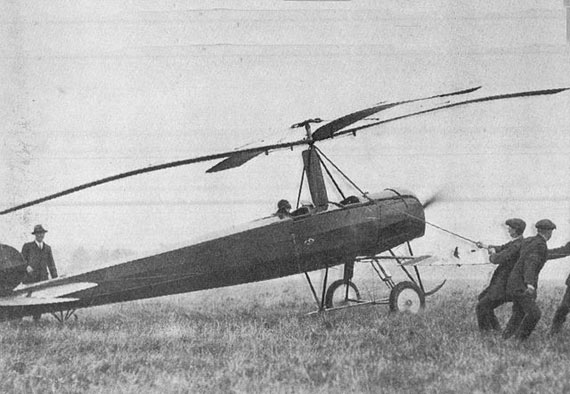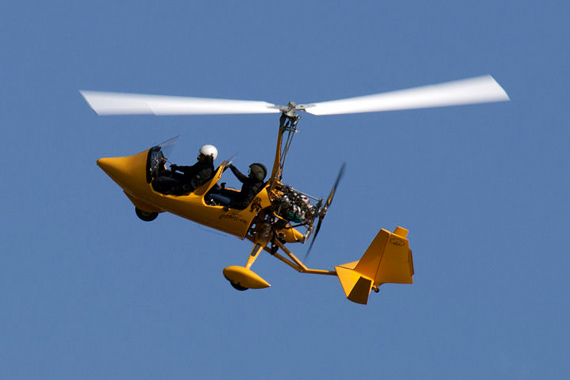The January 1930 issue of Popular Mechanics magazine devoted much of its content to aviation, one of the great advances that was all the rage at the time. One article looked at the safety of aircraft, while an illustrated report showed that modern aircraft were already offering luxuries such as electric ovens, curling irons, refrigerators or billiards tables. Another piece showed a promising innovation called a “windmill plane”, or autogyro, the great invention developed by the Spanish aviator Juan de la Cierva, that preceded the helicopter.

The article explained how De la Cierva had suffered an accident that occurred when a tri-motored biplane built by him had stalled and crashed. From that experience, the Spaniard had pursued the design of a safer aircraft that would not lose its lift even at very low speeds, and which could land almost vertically. The result of his work was an aircraft crowned by four long rotor blades that spun freely with the force of the air. «I believe the autogyro will be of special help in the development of civil aviation —where safety is paramount», declared De la Cierva to Popular Mechanics.
The autogyro differs from conventional aircraft in that most of the lift does not come from the fixed wings, but rather from the rotor, which becomes a movable wing that rotates. As De la Cierva explained to Popular Mechanics, the rotor acts as a parachute, allowing an even slower descent than would a parachute with the same diameter as the rotor.
Safer than Airplanes and Helicopters
The concept of the movable wing of an autogyro is reminiscent of a helicopter, but there is one fundamental difference: in a helicopter the rotor is driven by a motor, while the blades of an autogyro only rotate thanks to the relative speed of the air when the plane moves. In the words of aerospace engineer Jeff Lewis, who has researched the history of the invention and its creator, the rotor of an autogyro «is made to spin by aerodynamic forces, through a phenomenon called autorotation. Since the rotor is not powered, an autogyro needs a separate source for propulsion, like an airplane. Conventionally, these have been propellers, but it’s possible to use jet engines as well.» By contrast, «a helicopter gets its propulsion by tilting the rotor forward.»
This rotation driven by the wind was what made De la Cierva’s autogyro safer than airplanes and helicopters. If the engine stopped, the rotor would continue to rotate and the unit would simply glide gently to the ground instead of crashing. In fact, as Lewis explains, «the procedure for landing an autogyro after an engine failure was the same as for landing it under normal circumstances,» since it was usual to cut the propulsion before landing.
De la Cierva, a Precocious Aviator
The inventor of this ingenuity was born in Murcia (Spain) 120 years ago, on September 21, 1895. The well-off position of his family, established in the world of politics and business, allowed him to study road engineering and to found, together with two friends, a company dedicated to the development of the nascent field of aviation. They were just teenagers when their first prototype, a biplane, was released in 1912, nine years after the historic flight of the Wright brothers in North Carolina, USA.

That aircraft called BCD-1 Cangrejo (Crab in English) was the first Spanish-manufactured aircraft, built on the basis of a French Sommer. The plane flew, but subsequent attempts by De la Cierva failed. When his third model, the C-3, crashed due to flying too slowly, the engineer decided to conceive another type of aircraft that would be safer. By this time flying toys had become popular, fitted with a horizontal propeller that spun when the device was dropped from a height. De la Cierva came up with his idea when launching one of these models from the balcony of his parents’ house.
The Rise of the Autogyro
His engineer career began to take off in 1920 in Madrid with the construction of the first autogyro, the Cierva C.1. Although the craft never got off the ground, it proved that the principle of the self-turning rotor was valid. The main design problem was an asymmetry in the lift that caused instability in the machine. The C.2 and C.3 also suffered from this defect, and it was not until 1922 that it occurred to De la Cierva, apparently while attending the opera, that more flexible blades would eliminate the problem. The C.4, with joints at the base of the blades, successfully took off from the airfield of Getafe (Madrid) in January 1923, covering 183 meters under the command of Flight Lieutenant Alejandro Gómez Spencer.

With his principle having been proven, De la Cierva received a grant from the Spanish government and began promoting his invention. After an exhibition in the UK, he was invited to continue his work in that country, where he founded the Cierva Autogyro Company in 1926 thanks to financial support from Scottish industrialist James G. Weir and the collaboration of the aircraft manufacturer Avro, which supplied the chassis. From its UK headquarters, the company worked to refine its aircraft and sold manufacturing licenses in France, Germany and the United States. In 1928 an autogyro completed a journey of 4,800 kilometers over the British Isles, and on September 18 in the same year De la Cierva piloted his own C.8 from London to Paris, crossing the English Channel with French journalist Henri Bouché as a passenger.
When in 1930 the autogyro appeared in that issue on aviation of the magazine Popular Mechanics, the aircraft was riding the crest of the wave, manufactured under license in the US and attracting great interest. In the article, the inventor predicted a bright future for his creation: «To fly the autogyro without risk, only a few hours’ training are necessary,» stated De la Cierva. «In addition, the autogyro will make possible the utilization of very small fields as landing grounds,» he continued. «The romantic roof landing is no longer a dream, and I hope that, before long, we will see autogyro parking spaces in middle of the cities.»
A Broken Dream
However, the prediction of De la Cierva never came to pass. Despite being a safe aircraft and easy to use, it never succeeded. According to the researcher Jeff Lewis, several factors contributed to its abandonment. The autogyro could not reach the speeds required in commercial aviation, and for slow flight there was another option: by then, several pioneers were working on the idea of the helicopter, which arose independently. However, as Lewis points out, the first helicopter that in 1935 succeeded to fly, the Breguet-Dorand 314, incorporated several innovations that had their origin in the autogyro. The helicopter became the preferred choice by offering advantages such as the possibility of hovering in the air, but the perfecting of this aircraft took advantage of the understanding of aerodynamics achieved by De la Cierva during the construction of his autogyros.
In short, «anything an autogyro could do could be done by another aircraft,» writes Lewis. Moreover, «most people did not understand how it worked and so did not trust it. Although it is actually safer than either helicopters or airplanes, people did not realize this. They wanted something powered.»
But also, adds Lewis, the invention declined due to the untimely death of its main promoter. The aviation pioneer died in a plane crash. As a fatal irony, it was not in one of his own safer aircraft, but rather in a conventional airplane. On December 9, 1936, the DC-2 from the company KLM that was transporting De la Cierva to Amsterdam crashed after takeoff from the Croydon airport, in London. The cause of the accident has never been made clear.
The Autogyro: Does it Have a Future?
After the death of De la Cierva, his company continued to work on and manufacture autogyro models, but the preference of the British Royal Navy for helicopters caused the company to refocus on that new machine in which De la Cierva himself did not believe, considering it «too complex».

Nowadays, the autogyro has been quite relegated to the ambit of amateur sport aviation and modeling enthusiasts. However well into the 21st century at least two US companies, Groen and Carter, have resurrected the concept with the goal of making it used again in the fields of personal aircraft and police surveillance. Another experimental vehicle, the Dutch PAL-V One, applies the principle of the autogyro to the idea of the flying car. Perhaps one day after all we will get to see modern autogyros flying over cities, just as De la Cierva predicted.
By Javier Yanes for Ventana al Conocimiento
@yanes68
Comments on this publication